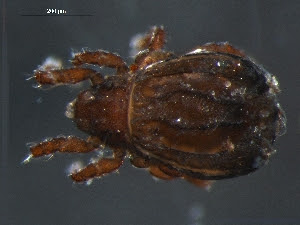The animal in the above pictures is a typical representative of the Camisiidae, a widely distributed family of oribatid mites. Members of this family can be found in soil, on the trunks of trees, or hidden among mosses and lichens. They are slow-moving animals and are often concealed from potential predators by an encrusting layer of dirt and organic debris. Carrying this encrusting layer may be related to a reduction in the offensive chemical-producing glands that are used by many other oribatids for defense (Raspotnig et al. 2008). In members of the genus Camisia, the openings of these glands are completely covered by dirt, but in the genera Platynothrus and Heminothrus the openings still protrude above the encrustation. The recently described Paracamisia osornensis, which does not carry an encrusting layer, retains a large offensive gland (Olszanowski & Norton 2002).
Close to 100 species have been assigned to this family; though found in most parts of the world, camisiids are most diverse in the Northern Hemisphere. One species in particular, Platynothrus peltifer, is almost global in distribution and the range of habitats in which it has been found includes soil, litter, peat and even aquatic habitats (Norton & Behan-Pelletier 2009) When one is as small and metabolically undemanding as these animals are, there may be surprisingly little difference between being out in the air or immersed in water, and even primarily terrestrial oribatids may survive submersion almost indefinitely. Genetic studies of P. peltifer have identified a high level of within-species divergence and it has been calculated on this basis that this species may have survived almost unchanged in external appearance for some 100 million years (Heethoff et al. 2007).
The Camisiidae are closely related to another oribatid family, the Crotoniidae, that is found in South America and Australasia. One of the more significant differences between the two families is that whereas the camisiids appear to be entirely parthenogenetic, crotoniids reproduce sexually. Recent analyses, both molecular and morphological, indicate that the 'camisiids' are paraphyletic with regard to the crotoniids, leading Colloff & Cameron (2009) to treat the latter as a subfamily, Crotoniinae, of the former. This re-classification has been accepted by other authors though the law of priority requires that the combined family should be known as the Crotoniidae, not Camisiidae. The nested position of the sexual crotoniines within the asexual 'camisiids', with other related oribatid families also being asexual, has led to the suggestion that the crotoniines have somehow re-evolved sexuality. This would be fascinating if true, seemingly violating the usual principle that complex features can't be re-evolved once lost. Personally, I tend to be sceptical of claims like this (see this old post, for instance). I would like to see evidence beyond simple phylogenetic position to indicate if this is a true re-evolution rather than an historical bias towards loss of sexuality giving a misleading image.
REFERENCES
Colloff, M. J., & S. L. Cameron. 2009. Revision of the oribatid mite genus Austronothrus Hammer (Acari: Oribatida): sexual dimorphism and a re-evaluation of the phylogenetic relationships of the family Crotoniidae. Invertebrate Systematics 23: 87–110.
Heethoff, M., K. Domes, M. Laumann, M. Maraun, R. A. Norton & S. Scheu. 2007. High genetic divergences indicate ancient separation of parthenogenetic lineages of the oribatid mite Platynothrus peltifer (Acari, Oribatida). Journal of Evolutionary Biology 20: 392–402.
Norton, R. A., & V. M. Behan-Pelletier. 2009. Suborder Oribatida. In: Krantz, G. W., & D. E. Walter (eds) A Manual of Acarology 3rd ed. pp. 430–564. Texas Tech University Press.
Olszanowski, Z., & R. A. Norton. 2002. Paracamisia osornensis gen. n., sp. n. (Acari: oribatida) from Valdivian forest soil in Chile. Zootaxa 25: 1–15.
Raspotnig, G., E. Stabentheiner, P. Föttinger, M. Schaider, G. Krisper, G. Rechberger & H. J. Leis. 2008. Opisthonotal glands in the Camisiidae (Acari, Oribatida): evidence for a regressive evolutionary trend. Journal of Zoological Systematics and Evolutionary Research 47 (1): 77–87.


















A species 100 Ma old? Cool. Though with parthenogenetic lineages the concept of "species" gets even more slipperty than usual.
ReplyDeleteSo these would be another huge exception to the "rule" that parthenogenetic lineages don't last long (the one that gets mentioned every time I see the "rule" mentioned is the bdelloids).
Indeed, though it would be nice if we could get some sort of external confirmation of P. peltifer's age from the fossil record.
DeleteQuote:
ReplyDelete"This would be fascinating if true, seemingly violating the usual principle that complex features can be re-evolved once lost."
Did you mean "can't"?
I did indeed. Corrected, thanks.
Delete